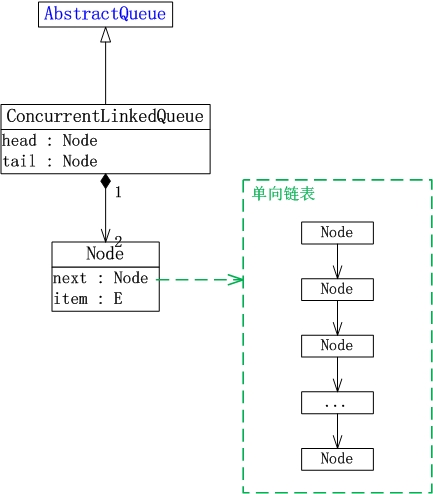一、ConcurrentLinkedQueue介绍
ConcurrentLinkedQueue是线程安全的队列,它适用于“高并发”的场景。它是一个基于链接节点的无界线程
安全队列,按照 FIFO(先进先出)原则对元素进行排序。队列元素中不可以放置null元素(内部实现的特殊
节点除外)。
二、ConcurrentLinkedQueue原理和数据结构
ConcurrentLinkedQueue的数据结构,如下图所示:

说明:
1. ConcurrentLinkedQueue继承于AbstractQueue。
2. ConcurrentLinkedQueue内部是通过链表来实现的。它同时包含链表的头节点head和尾节点tail。
ConcurrentLinkedQueue按照 FIFO(先进先出)原则对元素进行排序。元素都是从尾部插入到链表,从头
部开始返回。
3. ConcurrentLinkedQueue的链表Node中的next的类型是volatile,而且链表数据item的类型也是
volatile。关于volatile,我们知道它的语义包含:“即对一个volatile变量的读,总是能看到(任意线程)对这
个volatile变量最后的写入”。ConcurrentLinkedQueue就是通过volatile来实现多线程对竞争资源的互斥访
问的。
三、ConcurrentLinkedQueue原理和数据结构
// 创建一个最初为空的 ConcurrentLinkedQueue。
ConcurrentLinkedQueue()
// 创建一个最初包含给定 collection 元素的 ConcurrentLinkedQueue,按照此 collection 迭代器的遍历顺序来添加元素。
ConcurrentLinkedQueue(Collection<? extends E> c)
// 将指定元素插入此队列的尾部。
boolean add(E e)
// 如果此队列包含指定元素,则返回 true。
boolean contains(Object o)
// 如果此队列不包含任何元素,则返回 true。
boolean isEmpty()
// 返回在此队列元素上以恰当顺序进行迭代的迭代器。
Iterator<E> iterator()
// 将指定元素插入此队列的尾部。
boolean offer(E e)
// 获取但不移除此队列的头;如果此队列为空,则返回 null。
E peek()
// 获取并移除此队列的头,如果此队列为空,则返回 null。
E poll()
// 从队列中移除指定元素的单个实例(如果存在)。
boolean remove(Object o)
// 返回此队列中的元素数量。
int size()
// 返回以恰当顺序包含此队列所有元素的数组。
Object[] toArray()
// 返回以恰当顺序包含此队列所有元素的数组;返回数组的运行时类型是指定数组的运行时类型。
<T> T[] toArray(T[] a)
四、ConcurrentLinkedQueue示例
import java.util.*;
import java.util.concurrent.*;
/*
* ConcurrentLinkedQueue是“线程安全”的队列,而LinkedList是非线程安全的。
*
* 下面是“多个线程同时操作并且遍历queue”的示例
* (01) 当queue是ConcurrentLinkedQueue对象时,程序能正常运行。
* (02) 当queue是LinkedList对象时,程序会产生ConcurrentModificationException异常。
*
* @author skywang
*/
public class ConcurrentLinkedQueueDemo1 {
// TODO: queue是LinkedList对象时,程序会出错。
//private static Queue<String> queue = new LinkedList<String>();
private static Queue<String> queue = new ConcurrentLinkedQueue<String>();
public static void main(String[] args) {
// 同时启动两个线程对queue进行操作!
new MyThread("ta").start();
new MyThread("tb").start();
}
private static void printAll() {
String value;
Iterator iter = queue.iterator();
while (iter.hasNext()) {
value = (String) iter.next();
System.out.print(value + ", ");
}
System.out.println();
}
private static class MyThread extends Thread {
MyThread(String name) {
super(name);
}
@Override
public void run() {
int i = 0;
while (i++ < 6) {
// “线程名” + "-" + "序号"
String val = Thread.currentThread().getName() + i;
queue.add(val);
// 通过“Iterator”遍历queue。
printAll();
}
}
}
}
结果说明:如果将源码中的queue改成LinkedList对象时,程序会产生ConcurrentModificationException异常。
五、转载地址
http://www.cnblogs.com/skywang12345/p/3498995.html






















 464
464

 被折叠的 条评论
为什么被折叠?
被折叠的 条评论
为什么被折叠?








